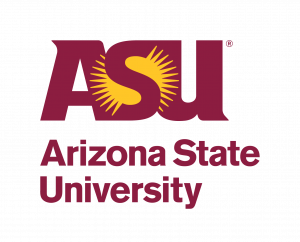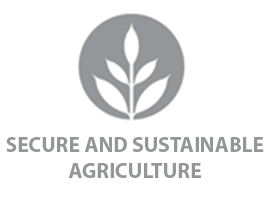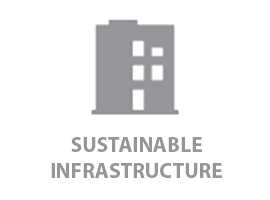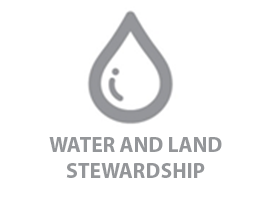Multi-Paddock Grazing Project
Research Menu
 Current
Current
Funded
iSEE Work
 Current
Current
Funded
iSEE Work
Current
Funded
iSEE Work
Current
Funded
iSEE Work
Current
Funded
iSEE Work
Project Overview
![]()
![]() The Multi-Paddock Grazing Project fits into the iSEE research themes of Water and Land Stewardship and Secure and Sustainable Agriculture.
The Multi-Paddock Grazing Project fits into the iSEE research themes of Water and Land Stewardship and Secure and Sustainable Agriculture.

In Lead Investigator Nuria Gomez-Casanovas’ words:
“Agricultural systems must adapt to increasing demands for food, while facing increasing threats, particularly related with the loss of ecosystem services. To meet this challenge, future food production needs new agricultural management strategies that increase ecosystem services while enhancing food production.
“We will investigate how emerging adaptive multi-paddock grazing management (AMP) that has the potential to increase soil carbon sequestration compared to the ‘business as usual’ continuous grazing (CG) affects the delivery of regulating services — greenhouse gas (GHG) regulation and water use efficiency (WUE) — from grazed pastures used for livestock production.
“The outcomes of the proposed research will reduce the uncertainty surrounding GHG emissions and WUE of grazed pastures using current and emerging management techniques. The proposed research will fill major knowledge gaps in how AMP grazing affects ecosystem productivity, net ecosystem GHG exchange (CO2, CH4 and N2O), and WUE of pastures.”
Project News
- Summer 2021 Progress update
- Summer 2020 Progress update
- Summer 2019 Progress update
- iSEE Helps Secure Grant through Arizona State University

Details of a recently grazed paddock (right) and a paddock that started being grazed (left)a few hours earlier.
From Principal Investigator Nuria Gomez-Casanovas, an update on the project midway through its third funded year:
- The Illinois team is working with Arizona State University and other partners to submit a new proposal to the Foundation for Food and Agriculture Research (FFAR) to study how AMP impacts the delivery of ecosystem services of temperate grasslands (that proposal is for $3 million total and is pending). Findings from our Southeastern Adaptive Multipaddock and Continuous Grazing sites served as the conceptual framework to hypothesize how AMP could impact regulating services in temperate grasslands located in the Northern Great Plains.
- The team completed its second year of:

PI Nuria Gomez-Casanovas taking soil cores in an AMP pasture located in Piedmont, Ala.
- eddy covariance data, including CO2 and CH4 net ecosystem exchange;
- N2O measurements; and
- Net Primary Productivity and grazing intensity measurements.
- Field and Lab Specialist Daniel Hong joined the team in July 2020 and has taken care of field and lab measurements since then. During the time, he has been managing four eddy covariance and micrometeorological towers equipped with CO2, H22O and CH4 sensors.
- The team made a presentation in 2020 and published a paper (see below). In that paper, “We investigated four novel strategies to mitigate warming and enhance efficiency of grasslands (productivity, and land, nutrient and water use). We discovered that adopting some of these strategies could offer almost exclusively environmental benefits, and that they have the potential to enhance the resilience of grasslands to climate change. Future research work is needed to secure food and energy from sustainable grasslands using these strategies.”
From Principal Investigator Nuria Gomez-Casanovas, an update on the project midway through its second funded year:
- The Illinois team has secured two more grants totaling $325,000 from ExxonMobil and McDonald’s foundations through Arizona State University. This additional funding for 2020-21 extends the original subaward from ASU.
- The team completed its first year of:
- eddy covariance data, including CO2 and CH4 net ecosystem exchange;
- N2O measurements; and
- Net Primary Productivity and grazing intensity measurements.
- “Preliminary results suggest that Adaptive Multi-Paddock (AMP) management affects the net CO2 sink capacity of grasslands through changes in gross primary productivity and ecosystem respiration, and that its impact is regulated by grazing intensity. Grazing intensity and precipitation dominate the N2O and CH4 source strength of AMP and continuous grazing (CG) pastures. Preliminary results suggest that AMP pastures can be more productive than CG pastures due to planting more diverse highly productive plant species and enhanced soil hydric status in AMP compared to CG pastures.”
- The team made two presentations in 2019 and has a paper in preparation (see below).
From Principal Investigator Nuria Gomez-Casanovas, an update on the project for which iSEE helped secure funding in Fall 2018:
 “With global population rising at an unprecedented rate, food production must increase to feed 11 billion people over the next 40 years despite the degradation and loss of ecosystem services due to management intensification and impeding stresses of changes in climate,” she said. “Society needs management strategies that increase food production without damaging the environment. Discoveries from the AMP team hope to play an important role in addressing this challenge.”
“With global population rising at an unprecedented rate, food production must increase to feed 11 billion people over the next 40 years despite the degradation and loss of ecosystem services due to management intensification and impeding stresses of changes in climate,” she said. “Society needs management strategies that increase food production without damaging the environment. Discoveries from the AMP team hope to play an important role in addressing this challenge.”
The AMP team’s research is conducted in Southeastern U.S. subtropical humid grasslands located in Alabama, a biome that make up to 30% of grasslands globally. In April 2019, the team installed four eddy covariance towers (pictured) in four grasslands, two under AMP management and the other two under CG management.
“Since then we have been measuring the exchange of CO2, CH4 and N2O between these grasslands and the atmosphere with these towers,” Gomez-Casanovas said. “The AMP team also started measuring discrete N2O and CH4 fluxes from soil over two weeks following grazing, and over three days a month after grazing, to capture variability in CH4 and N2O fluxes in response to grazing and climate.”
Samplings for discrete measurements of these GHGs will occur four times a year. Efforts already have begun to couple discrete N2O and CH4 measurements with biogeochemical modeling to obtain annual N2O and CH4 flux estimates from soil from AMP- and CG-managed subtropical pastures. Undergraduate David Wilkerson-Lindsey is helping with fieldwork and data processing, and Undergrad Daniel Parra is helping build a database in grassland biogeochemistry that we will use to calibrate and validate DayCent, a process-based biogeochemical model that we will use to obtain accurate annual N2O and CH4 measurements in soil from subtropical pastures managed under AMP and CG regimes.
“Agriculture is a major user of ground and surface water in the U.S. (80% of U.S. consumption’s water is dedicated to agricultural activities) and an important contributor to nitrogen (N) pollution,” she said. “One of the most dramatic examples of the consequences of poor management of agricultural systems related to water regulation is the Gulf of Mexico dead zone caused by N leaching from agricultural fertilizers.”
As management of agricultural land can profoundly affect the water footprint for food production and water quality, the AMP team added a new research priority in 2019 to elucidate how AMP influences the use of water of pastures to produce forage and how it affects water quality running-off temperate grasslands.
“We will couple annual measurements of nitrate runoff from each treatment as a measure of water quality with H2O loss measured using the eddy covariance technique to understand changes in water-related regulating services in response to management,” Gomez-Casanovas said.
The project has received an additional $135,135 grant (2019-20) from the Arizona State University Foundation and ExxonMobil to continue investigating how AMP and CG impact the delivery of greenhouse gases (GHGs) and water-related regulating services from subtropical humid grasslands.
In addition, the U of I team in collaboration with other researchers on the AMP project at ASU has reached out to other potential funders, she said.
 The Institute for Sustainability, Energy, and Environment (iSEE) was instrumental in helping a University of Illinois team land iSEE Visiting Research Scientist Nuria Gomez-Casanovas, Baum Family Director Evan H. DeLucia, and Postdoctoral Research Associate Elena Blanc-Betes $663,585 from the Arizona State University Foundation for a study titled “Can Adaptive Multi-Paddock Grazing Management Increase the Net Greenhouse Gas Sink Strength and Water Use Efficiency of Grazed Pastures?”
The Institute for Sustainability, Energy, and Environment (iSEE) was instrumental in helping a University of Illinois team land iSEE Visiting Research Scientist Nuria Gomez-Casanovas, Baum Family Director Evan H. DeLucia, and Postdoctoral Research Associate Elena Blanc-Betes $663,585 from the Arizona State University Foundation for a study titled “Can Adaptive Multi-Paddock Grazing Management Increase the Net Greenhouse Gas Sink Strength and Water Use Efficiency of Grazed Pastures?”
The team will be part of a collaborative effort to study if a new grazing practice can help sequester carbon in soils, thus helping to regulate greenhouse gas emissions — and increase water use efficiency on farmlands. The ASU Foundation received matching $1.25 million grants from the Foundation for Food and Agriculture Research (FFAR) and McDonald’s Corp. for this study.
The Team

From left: Evan H. DeLucia, Nuria Gomez-Casanovas, and Elena Blanc-Betes.
Principal Investigator (PI) and co-PIs
- Nuria Gomez-Casanovas (PI), iSEE Visiting Researcher, University of Illinois Urbana-Champaign
Lab page >>> - Evan H. DeLucia (Co-PI), Arends Professor Emeritus of Plant Biology, University of Illinois Urbana-Champaign
School of Integrative Biology profile page >>>
Lab page >>> - Elena Blanc-Betes (Co-PI), iSEE Postdoctoral Research Associate, University of Illinois Urbana-Champaign
Lab page >>>
Read more about Elena and her work >>>
Illinois Operating Team (Postdocs, Technicians, Students)
- Sunghoon (Daniel) Hong, Field and Lab Specialist
Former Illinois Team Members
- Aidan McMahon, Field and Lab Technician
- Daniel Parra, Undergraduate in Technical Systems Management
- David Wilkerson-Lindsey, Undergraduate in Integrative Biology and Earth, Society and Environmental Sustainability
Researchers on the original ASU Project
- Peter Byck (Lead PI), Professor of Practice, School of Sustainability, Walter Cronkite School of Journalism and Mass Communications, ASU
His ASU page >>> - Steve Apfelbaum (Co-PI), Principal Ecologist, Founder, and Chairman, Applied Ecological Services Inc.
His AES page >>> - Jason Rowntree (Co-PI), Associate Professor of Animal Science, Michigan State University
His MSU page >>> - Allen Williams (Co-PI), Chief Ranching Officer, Joyce Farms
His Joyce Farms page >>> - Russ Conser, Chief Executive Officer, Standard Soil
His Standard Soil page >>> - Francesca Cotrufo, Professor of Soil Ecology, Colorado State University
Her CSU page >>> - Jennifer Hodbod, Assistant Professor of Community Sustainability, Michigan State University
Her MSU page >>> - David Johnson, Research Scientist and Molecular Biologist, Institute for Sustainable Agricultural Research, New Mexico State University
The Institute page >>> - Michael Lehman, Research Microbiologist, U.S. Department of Agriculture Agricultural Research Service, Brookings, S.D.
His USDA page >>> - Jonathan Lundgren, Founder and Director, Ecdysis Foundation
His Ecdysis page >>> - Keith Paustian, Professor of Soil Ecology, Colorado State University
His CSU page >>> - Benjamin Runkle, Assistant Professor of Biological and Agricultural Engineering, University of Arkansas
His Arkansas page >>> - Janice Swanson, Professor of Animal Science and Director of Animal Welfare, Michigan State University
Her MSU page >>> - Wendy Taheri, Microbiologist, TerraNimbus LLC
The TerraNimbus page >>> - Greg Thoma, Professor of Chemical Engineering, University of Arkansas
His Arkansas page >>>
Granting Partners
- The Foundation for Food and Agriculture Research (FFAR) awarded $1.25 million to the ASU Foundation
- McDonald’s Corp. matched FFAR, Shell, and ExxonMobil Foundations’ $1.25 million — part of its $4.5M commitment to grazing research
Publications & Presentations
(iSEE project members’ names in bold):
- Publication: “A Review of Transformative Strategies for Climate Mitigation by Grasslands.” Gomez-Casanovas, N.; Blanc-Betes, E.; Moore, C.; Bernacchi, C.J.; Kantola, I.; DeLucia, E.H. Science of the Total Environment (August 2021)
- Presentation: “Transformative Management Approaches for Grasslands.” Gomez-Casanovas N.; Blanc-Betes, E.; Moore, C.; Bernacchi, C.J.; Kantola, I.; DeLucia, E.H. American Geophysical Union annual meeting, San Francisco, December 2020.
- Presentation: “Impact of Improved Management and Patch-Burn Grazing on the Net CO2 Sink Strength of Subtropical Humid Grasslands.” Gomez-Casanovas N.; Bernacchi C.J.; Boughton, E.H.; Dracup, E.; Pierre, S.; Saha, A.; Boughton, R.; Smith, B.; Sparks, J.; Swain, H.; DeLucia, E.H. American Geophysical Union annual meeting, San Francisco, December 2019.
- Presentation: “Improving Climate and Water Regulation Services from Grasslands with Adaptive Multi-Paddock Grazing Management.” Gomez-Casanovas N.; DeLucia, E.H. McDonald’s Headquarters, Chicago, August 2019.
- Presentation: “Improved Grazing Management Increases Soil Carbon Sequestration in Subtropical Pastures.” Gomez-Casanovas, N.; Blanc-Betes, E.; Boughton, E.H.; Bernacchi, C.J.; DeLucia E.H. American Geophysical Union meeting, Washington, D.C., December 2018.
- Presentation: “Can Adaptive Multi-Paddock Grazing Management Increase the Net Greenhouse Gas Sink Strength of Grazed Pastures?” Gomez-Casanovas, N.; DeLucia, E.H. McDonald’s Headquarters, Chicago, Ill., November 2018.


